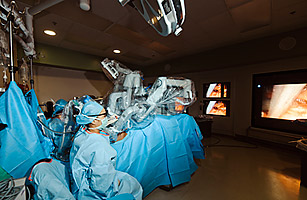
(4 of 4)
The Inevitable Backlash
For Menon's teacher, the eminent Dr. Walsh, the glamour of robotic surgery is a distraction from what should be the crucial issue: the skill and experience of the surgeon. No tool, Walsh says, can match his hard-won ability to feel his way around the delicate veil of nerves that control erections, judging by touch whether cancerous adhesions have begun to spread from the prostate gland. Whatever a robot might offer in terms of clear sight and fine-tuned movements can't make up for the loss of touch, Walsh maintains. And he argues that improvements in the open technique by leading surgeons have shortened recovery time — a point echoed by another highly experienced open surgeon, Herbert Lepor of New York University. "In essence, we transformed open ... prostatectomy into a minimally invasive surgical procedure," Lepor wrote recently.
The harshest critics of the surgical robot go well beyond that critique. They don't just dispute its advantages; they believe that the robotic revolution has actually hurt thousands of prostate-cancer patients — and may lead to unnecessary procedures of other kinds as well. How so? When a hospital invests that much money to buy a surgical robot and train surgeons to use it, it creates pressure to sell surgery over other therapies. At the same time, the minimally invasive robot is less frightening than an operation involving a big cut or split bones. So patients may be more likely to choose robotic surgery.
In their provocative book, Invasion of the Prostate Snatchers, cancer patient Ralph Blum and oncologist Mark Scholz decry the rising number of prostatectomies performed in the U.S. — many of which, according to emerging data, do nothing to extend the lives of patients. Prostate cancer, in most cases, is a slow-growing disease affecting older men. "The vast majority of men with prostate cancer would have lived just as long without any operation at all," but "their rational thinking has been short-circuited by the word cancer," the authors write. "Scared, frantic and vulnerable — relying on a doctor's insight — they are ripe to being sold on surgery as their best option."
That cynical view of doctors makes Menon wince: "I was Pat Walsh's resident when he performed the first radical retropubic prostatectomy" — the technique that Menon later adapted to the robot. "At the time, 40% of patients had metastatic disease," meaning that their cancer had spread beyond the prostate and their chance of a cure was remote. Anyone who has seen a man in the last stages of prostate cancer knows what a slow, painful death looks like. "It's very disturbing to watch men dying so miserably," says Menon. Today, the death rate from prostate cancer is at an all-time low, though experts don't agree on precisely why. If prostate cancer is being overtreated, the willingness of patients to choose surgery is, at least, understandable. Prostate-cancer patients know that surgery gives them a good shot at a cure, and a cure is what they seek. That, more than greedy surgeons, is the reason so many robots are whirring through so many surgeries.
The scientific way to settle these questions about cost vs. benefits would be to conduct a random trial in a large group of patients, assigning some to one treatment and others to another. At one point, Menon considered doing that, but quickly ran up against the American way: patients refused to go along. They wanted to choose their treatments for themselves.
Swiftly and overwhelmingly, they have chosen the robot. And so we find ourselves a decade down the road from the day Menon opened the doors on the Vattikuti Institute. More than $1 billion worth of robots are operating on tens of thousands of patients all over the country, with generally good results and minimal complications. Maybe the whole thing is a medical version of a Rolex watch: impressive and reliable, and yet an unnecessary extravagance. Maybe we can't afford a Rolex.
So many variables go into the treatment of disease — the patient's fitness, the doctor's skill, the virulence of the malady — that it may be impossible to isolate the precise value of each tool or technique. Certainly by the time enough data is collected to make a persuasive case, the robotic revolution will be so far along that it would be an infernal task to reverse it. This horse is long gone from its barn.
And that is the complicated reality of medical innovation. As Nancy Schlichting says, it's a good thing to say yes to creativity — even when we might not know the price tag. Today's costly venture may be the seed for tomorrow's cost- or life-saving breakthrough. "We're just seeing the tip of the iceberg for robotics," Menon declares. "One company has been making one product, but as more companies enter the market, costs will go down."
Menon understands that creativity cannot wait for absolute certainty. But he is completely sure of this much: "In the future, most surgery will be done in minimally invasive ways, assisted by computers. Will it necessarily look like this? Who knows?" he says with a shrug. "But medicine has to progress."